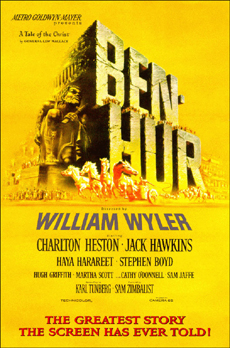As the movie begins, we meet Judah Ben-Hur (Charlton Heston), whose
former friend, a Roman named Messala (Stephen Boyd), returns to govern
Judea. But when Ben-Hur refuses to work for Messala and, therefore,
betray his own people, Arrius has him prosecuted for a minor offense.
Ben-Hur is separated from his family, forced into slave labor and longing
for revenge. This, of course, eventually leads to the famous chariot
race, where he competes agains Messala and several other competitors,
seeking to earn his revenge through a public humiliation of his former
friend.
Ben-Hur's connection with Jesus is tangential: he meets him briefly
a couple times. Ultimately, though, he comes to believe. Ben-Hur's conversion
is perhaps the only subtle aspect of a very theatrical movie.
Believe it or not, the story of Ben-Hur goes back nearly 80
years, with the first version being a 1880 novel by Lew Wallace. It
was then adapted into numerous stage versions, including one that acted
out the chariot race on-stage, using full-size chariots, horses, a treadmill
and moving scenery. Two previous silent movie versions preceded the
1959 movie. So while most of today's movie-goers know the story primarily
from the Charlton Heston version, at the time, the story was well-known
from other sources.
I'm glad that I finally saw this movie, because now I understand some
of the many references to it in pop culture. In particular, aside from
the similarity of the movie poster, I had no idea how many scenes were
echoed in Monty Python's Life of Brian, such as the beginning,
where the three wise men see a star and follow it to a manger. In a
way, you could call Life of Brian a tale of the Christ, as well,
because like Ben-Hur, it's set in biblical times but follows
an unrelated character.
Ben-Hur was very expensive to make, involving record amounts
spent on costumes, extras, scenery and sets. There were 15,000 extras
alone for the chariot race sequence. The money paid off: the movie still
looks great, even by today's steadily increasing standards. The outdoor
sets built for the chariot race were the largest built at the time.
To a 1959 audience, it must have seemed fabulous.
Burt Lancaster was considered for Ben-Hur but turned down the role
because he was a self-described atheist and didn't want to promote Christianity.
Paul Newman was also offered the role but turned it down because he
said he didn't have the legs to wear a tunic.
Heston, as was his habit, pulled out all the stops with his performance.
In nearly every scene, he wears a contorted mask of pain as he copes
with the many trials, and his fellow actors likewise engage in over-the-top
histrionics. The one exception is Boyd as Messala, who is believable
as someone who was once close to Ben-Hur and then becomes petty and
vindictive after being spurned.
The script of this movie was reshaped several times, with Gore Vidal
(ultimately uncredited due to behind-the-scenes credit dispute) playing
a key role in the portrayal of the relationship between Ben-Hur and
Messala. From his suggestion, the script and the performances portrayed
an implied intimacy between the two characters, who had clearly been
very dear friends. When they split ways, it's as bitter as a divorce.
The War of the Romans, you might call it.
One of the greatest spectacles in a grand movie, the chariot race is
a tour-de-force action scene. I was fascinated, watching the behind-the-scenes
documentary, to learn how the stunt coordinator simulated two men being
run over by horses. Watching the movie, I was fooled into believing
that some poor stunt men had been trampled, and I wondered how they
could have escaped injury. Turns out it was an extremely skillful use
of dummies with natural joints so they would respond much like an actual
person.
Ben-Hur is all about flash and dazzle, much like The Greatest
Show on Earth, the other Best Picture winner starring Heston. His
acting in that movie was actually more realistic, in part because the
story itself was smaller. Personally, I prefer his performance in The
Greatest Show on Earth, but on the whole, Ben-Hur is a better
film.
When you look at the competitors, there's little surprise that Ben-Hur
won, or that it raced away with 11 Oscars. The biggest movie often does
win, particularly if it does well in the box office. There's simply
no way any of the other films nominated could have competed. In addition,
being set in biblical times, even if it's not truly a story of the Christ,
gave the film added importance. It's worth seeing, if only for that
spectacle.


